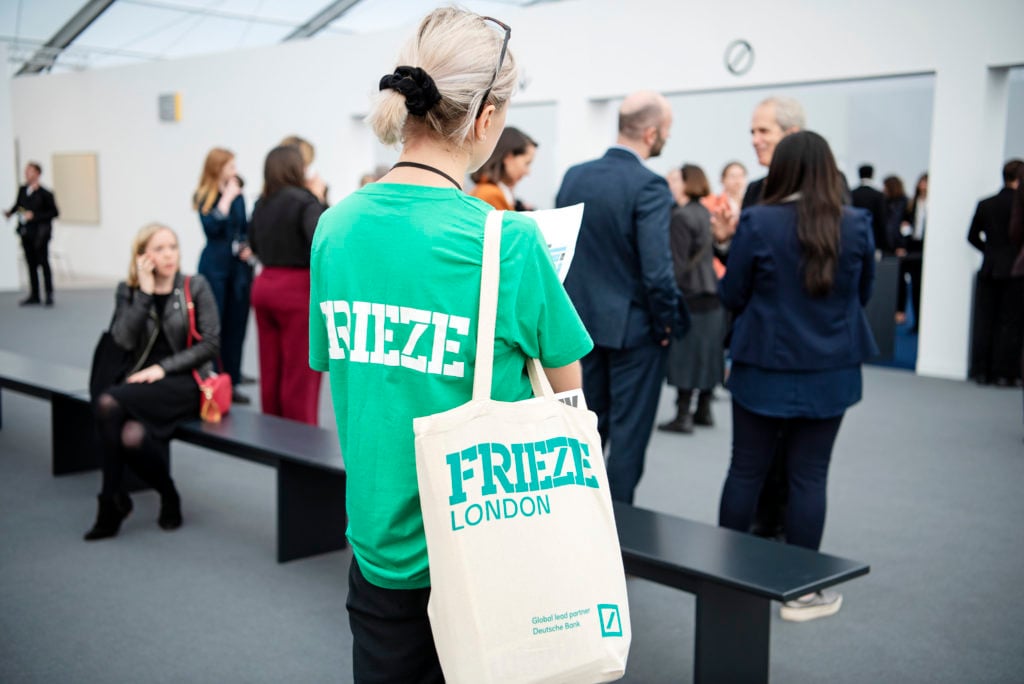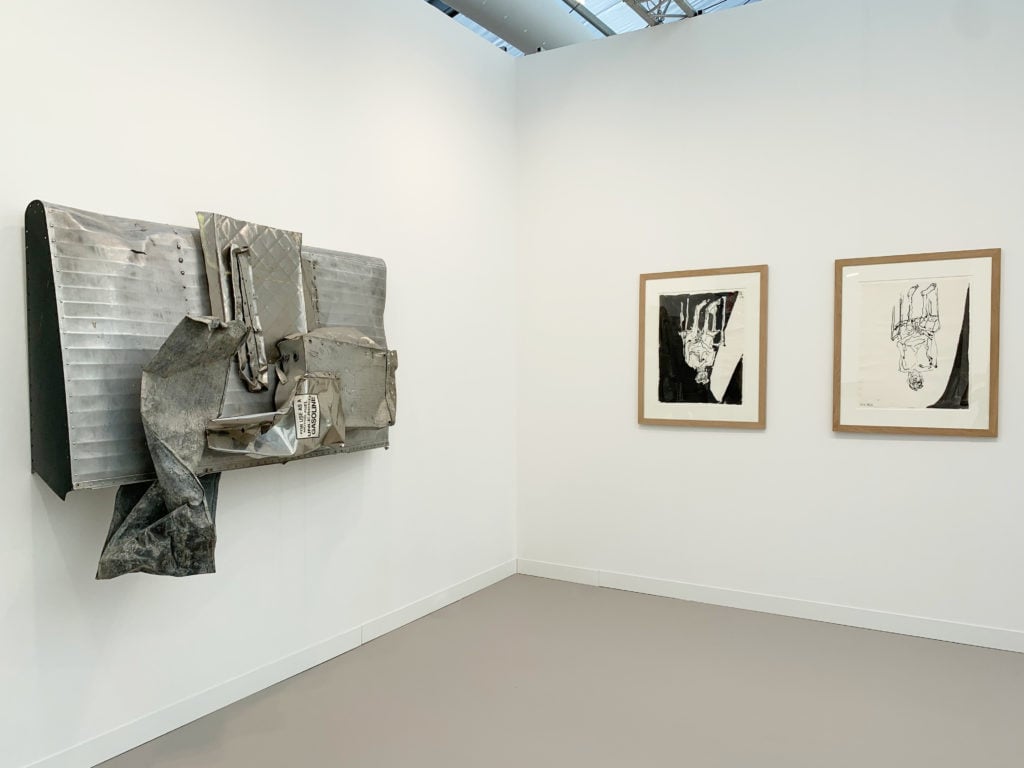Art Fairs
As the Art World Stomps Its Carbon Footprint Across London, Dealers and Frieze Are Innovating New Green Solutions
Thaddaeus Ropac is among the gallerists setting a green example by avoiding air transport and reusing crates.

Thaddaeus Ropac is among the gallerists setting a green example by avoiding air transport and reusing crates.

Javier Pes &
Naomi Rea

It ain’t easy being green in the globetrotting art world, but gallerists in London for Frieze this week are trying harder than ever to reduce their carbon footprint. The fair itself, which may look like a gas guzzling fiesta of conspicuous consumption, is, in fact, greener than ever.
The generators that keep the fair running and the booth lighting bright run on biodiesel fuel. “This year we are very excited to use a new fuel, Green D,” which is made from a waste vegetable oil, says Frieze art fair director Victoria Siddall says. Her expectation is that it will reduce the fair’s carbon emissions by 90 percent.
That is a big step, but in its war on waste, the fair has also banished a status symbol: plastic VIP cards. A-list collectors who arrived yesterday, October 2, instead brandished a digital version on their smart phones. It has stopped short of declaring a Tate-style climate emergency. (The BMW limo service between Frieze London and Masters is still running for super collectors.)

Robert Rauschenberg’s sculpture Bumper Slip Late Summer Glut (1987) on Thaddaeus Ropac’s booth at Frieze London 2019. Photo by CA Andrews, courtesy of Galerie Thaddaeus Ropac.
Leading art dealer Thaddaeus Ropac and his team are ahead of the green curve, reducing, recycling, and reusing whenever they can. The majority of the works in the gallery’s heavy-hitting booth at Frieze London, including appropriately a Robert Rauschenberg 1987 “glut” sculpture made of upcycled metal, were trucked in rather than shipped by air. Ropac says that whenever the gallery can, it ships large sculptures by sea.
Behind the scenes at any art fair you will find hundreds of bespoke crates being stored. At Art Basel they fill a whole floor of the vast exhibition hall. In the past, most would be single-use crates. To radically reduce the waste, Ropac is buying a warehouse in Paris with the sole purpose of storing crates so that they can be reused. (It is too costly to store them in high-security facilities where art is stored.) “I am looking for a building in London,” Ropac tells artnet News. “If we cannot reuse [crates], we try to recycle the wood,” he says.
“Many small steps” can lead to big changes, says Ropac, who has galleries in Paris, London, and Salzburg. He predicts that Brexit will mean more works have to be trucked from Paris to London, however. When deadlines are tight, or a collector wants to see a work ASAP, that might still mean flying it to London. “We used to fly all works from Paris but would not do that now,” he says.
Ropac, who has just flown back from Expo Chicago where his gallery made its Midwest debut, says that many works are still flown across the Atlantic for fairs but that is changing. “Shipping works to Miami will mean planning much earlier,” he says. “I think artists will go with the change in deadlines,” he says.
The brand color of this year’s Frieze London signage is green, but most collectors are probably unaware that the tent, walls of the booths, and the carpets are reused, including by other art fairs. The same is true of Frieze Masters. “We try to make sure materials are reused year after year,” Siddall says, adding, “We did our first carbon audit in 2007.”
While some fair directors might be reluctant to guide its exhibitors on such practices, Frieze is quietly evangelical. Siddall wrote to all the exhibitors on Saturday to explain what it was doing, and says the feedback has been positive. Now, Frieze is surveying all the galleries at this year’s fairs to see how they shipped works to and from the tents in London’s Regent’s Park. “Once we know, we will set a meaningful goal to reduce the amount of work shipped by air,” she says.
In Paris, too, new steps are being taken at FIAC, set to open in the Grand Palais hot on the heels of Frieze. The vast exhibition hall has the space to store all the wall partitions the fair needs, eliminating the need to truck them. Since Jennifer Flay took over as director, FIAC has shared the same walls with the Paris Photo fair. Flay says that the fair is committed to reducing its waste by 20 percent in 2019. It is due to take place in a temporary building during the Grand Palais’s revamp. The swanky structure near Eiffel Tower may have a second life, artnet News has learned.
One issue no fair director can escape is the environmental impact of encouraging so many exhibitors and collectors to travel from far and wide to attend their events. (There are so many private jets chartered by super collectors for a certain Swiss fair they can be held in a holding pattern for an hour.) The art industrial complex’s great gatherings run on aviation fuel washed down with champagne. “It is a real factor,” Siddall admits. “The art world flies a lot.”
Siddall says in defense of Frieze and Frieze week that “you can do an awful lot in one trip.” London’s museums and galleries pull out all the stops, so a jet setting collector, artist, or curator can at least make efficient use of their air miles.
This year in London the climate activist group Extinction Rebellion stopped traffic in the capital with their creative demonstrating. Members were outside the Frieze London tent, not to picket the fair, but urge visitors to curb their carbon emissions. The activists are due to speak inside the Frieze London tent on Sunday. “We heard on the grapevine that they wanted to do something, so we reached out to them,” Siddall says. “A lot of our audience as well as gallery clients are interested in hearing what they have to say.”
The eco-aware fair director cannot speak for everyone, however. At least one disgruntled collector was overheard today complaining about the newfangled digital VIP card that has to be downloaded in advance. They huffed: “I’d really like a plastic card.”